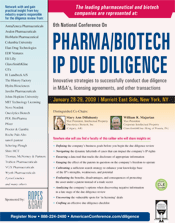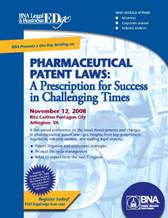Today the PTO published a notice in the Federal Register inviting public comments on paperwork burdens associated with the Ex parte Appeal Rule (73 Fed. Reg. 32937-32977, June 10, 2008). This Information Collection Request (ICR) an application from an agency to OMB for OMB’s approval under Paperwork Reduction Act, giving the agency authority to collect information from the public. The Information Collection Rule requires that the USPTO to develop and disseminate “an objectively supported estimate of burden.”
The Board of Patent Appeals and Interferences’ two main responsibilities include: (1) the review of ex parte appeals from adverse decisions of examiners in those situations where a written appeal is taken by a dissatisfied patent applicant and (2) the review of interferences to “determine priority” (that is, decide who is the first inventor) whenever an applicant claims the same patentable invention which is already claimed by another applicant or patentee. Each appeal and interference is heard by a merits panel of at least three members of the Board.
On September 26, 2007, the U.S. Patent and Trademark Office (PTO) submitted ICR 0651-0031 to the Office of Management and Budget (OMB) for review. OMB has extended its review of the ICR several times, but there is no public evidence that PTO has resolved these questions so that burden estimates can be finalized that adhere to both OMB’s Information Collection Rule and OMB’s Information Quality Guidelines.
The request for comment concerns new information collection requirements resulting from the promulgation of the proposed 5-25 Claim Rule, but it also refers to elements related to changes to information disclosure statements (IDSs) and the proposed Appeals and Markush Practice Rules.
The USPTO does not disclose any analysis of benefits, costs, or other effects in the notice of proposed rulemaking. The entire relevant text reads as follows (71 Fed. Reg. 38819):
This rulemaking has been determined to be not significant for purposes of Executive Order 12866 (Sept. 30, 1993).
Note that “not significant” is normally limited to regulatory actions that have minor consequences and elicit little or no controversy. Dr. Richard B. Belzer estimates that the PTO’s recent and anticipated regulatory actions will result in between 45 million and 73 million new burden-hours.
Dr. Belzer estimates that the total cost to the U.S, economy, just from the additional paperwork burden, could range from $13 billion to $34 billion per year. For perspective, note that the total paperwork budget for the Department of Commerce – PTO’s parent – is $1.7 billion.
The estimates of paperwork burden provided by PTO in its Supporting Statement were, in almost every instance, unsupported by any publicly disclosed data, models, or any other factual basis, even though the Office claims to adhere to applicable information quality guidelines.
The Paperwork Reduction Act (44 U.S.C. 3501 et seq, 5 C.F.R. Part 1320) is a very important but almost completely unknown law. It’s purpose is to protect the public from abusive governmental demands for information. Unlike previous notice-and-comment periods, this time any comments go to the Office of Management and Budget, a neutral arbiter outside the PTO whose statutory responsibility is to ensure that federal agencies treat the public fairly.
Without OMB’s approval, the Patent Office has no legal authority to compel patent applicants to comply with the Ex Parte Appeal Rule.
How can you respond?
The first thing to do is send an email request to the PTO asking for a copy of the relevant documents:
To: Susan.Fawcett@uspto.gov
Subject Line: 0651–00xx Board of Patent Appeals and Interferences (BPAI) Actions copy request
Message Body: Please send by reply email a copy of this ICR and the Supporting Statement.
Please include a bcc to Dr. Belzer (rbbelzer [at] post.harvard.edu) so that he can count how many requests are sent to the PTO as a result of this alert.
You should receive at least two documents (we are awaiting our copies). The text of the ICR will contain summary information. By regulation, the Supporting Statement must include objectively supported estimates of burden, and these estimates must be transparent and easy for you to reproduce to see how they did it.
For reference, the definition of paperwork “burden” is an expansive one; see below. Estimates based on the “professional judgment,” “belief,” or “opinion” of Patent Office personnel, or estimates with no disclosed basis, do not qualify as “objectively supported.”
For the next 30 days, OMB will be accepting public comment on the paperwork and recordkeeping burdens associated with the Appeal Rule. By law, OMB has 60 days to either approve or disapprove the ICR. That deadline will run out very close to December 10, 2008, effective date of the Appeal Rule.
For this reason, it is imperative that public comments be submitted as early as possible. Do not wait until Day 29 to decide to do this.
It is essential that OMB hear from you. The more thoughtful, reasoned, and documented public comments OMB receives, the better. Usually, OMB does not receive any public comments at all, and in these cases it is OMB is compelled by necessity to assume that what the agency provided is valid and reliable. Your comments can help ensure that OMB gets higher quality information.
Public comments on the ICR should be sent as soon as possible, and must be sent by November 7, 2008, via email to:
Nicholas A. Fraser
Desk Officer for USPTO
Office of Information and Regulatory Affairs
Office of Management and Budget
Nicholas_A._Fraser@omb.eop.gov
Public comments to OMB should address the following issues:
- Has the PTO provided an objectively-based estimate of the number of hours it will take to comply with the Appeal Rule? Historically, the Patent Office has severely underestimated the number of hours, and has failed to provide any analytical transparency into the sources or methods employed. Often, the PTO’s burden estimates consist of mere “judgment” or “belief.”
- Has the PTO provided an objectively-based estimate of the opportunity cost of each of these hours? Historically, the Patent Office has significantly understated the hourly cost of attorney time, and assumed that tasks normally performed by attorneys can be performed by lower-cost paralegals and administrative staff instead.
- Has the PTO provided an objectively-based estimate of the number of applications expected to be appealed? There is considerable controversy about how many appeals should be expected. For purposes of public comment on this ICR, the Continuations Rule, currently enjoined by the District Court in Tafas v. Dudas but now under appeal, should be assumed to apply. Do not assume that Tafas will be upheld. You are entitled to take the PTO at its word, that issues formerly resolved through continuations must now be resolved through appeal.
- Did PTO contact you for assistance or information to help them estimate the burden associated with the Ex parte Appeal Rule? By law and regulation, the PTO is required to consult with those who would bear the burden of complying with information collection requirements. They do not have to consult with all of you, but they do have to consult with some of you. Statements from the organizations that logically should have been consulted (e.g., AIPLA, ABA-IP, IPO, NAPP) stating that they were not consulted would be especially helpful.
- Which elements of the Ex Parte Appeal Rule require you to submit information that the PTO already has in its possession, albeit in another form? It is against the law for OMB to approve the collection of duplicative information. Thus, most contents of the appendix required by current and proposed 37 C.F.R. § 41.37(t) are simply illegal. Are there any other provisions that you believe are duplicative?
Definition of Burden under 5 C.F.R. 1320.3(b)(1):
Burden means the total time, effort, or financial resources expended by persons to generate, maintain, retain, or disclose or provide information to or for a Federal agency, including:
(i) Reviewing instructions;
(ii) Developing, acquiring, installing, and utilizing technology and systems for the purpose of collecting, validating, and verifying information;
(iii) Developing, acquiring, installing, and utilizing technology and systems for the purpose of processing and maintaining information;
(iv) Developing, acquiring, installing, and utilizing technology and systems for the purpose of disclosing and providing information;
(v) Adjusting the existing ways to comply with any previously applicable instructions and requirements;
(vi) Training personnel to be able to respond to a collection of information;
(vii) Searching data sources;
(viii) Completing and reviewing the collection of information; and
(ix) Transmitting, or otherwise disclosing the information.
The PTO has not made its submission to OMB requesting clearance under the Paperwork Reduction Act for the Appeal Rule easily available on its web site. However, the PTO’s submission is available at the OMB web site. The single most important document is here.
Further background is available here and here. The materials on the Appeal Rule and the public comments are available here and here.
Information for today’s post comes from Dr. Richard B. Belzer, a Harvard-educated, former White House staff economist, who provided one of the affidavits in the Tafas v Dudas litigation explaining the PTO’s lack of compliance with basic rulemaking procedure and gave OMB an analysis of the Continuations, Claims and IDS rules.



